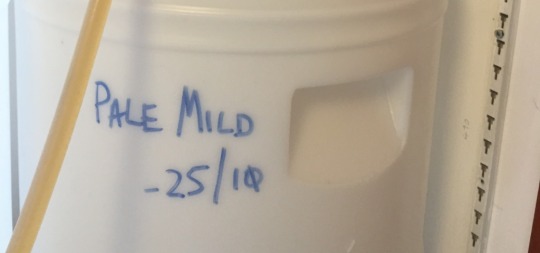This Is My Beer For That (or home brewing a Pale Mild)

Say hello to my latest home brew. This is my go at a Pale Mild.
“A pale mild? I thought mild was brown?” is what most people have said when I’ve told them about my latest brewing adventure. Mild means lots of things, but it doesn’t mean beer that is brown.
In my case, I’ve taken it to mean a mildly hopped beer, with some interesting flavours from the malts I’ve used.
Voile
I brew using a system called Brew-in-a-bag. It replaces the three or four vessels you usually need to brew with one — all thanks to a little voile bag. It works a charm for me.
The basic process is as follows:
- Line a pot with a voile bag.
- Add water to the pot.
- Heat water to a specific temperature, then stir in crushed, malted barley.
- Leave to sit, so the heat of the water converts starches to sugar.
- Take the bag out.
- Boil the remaining liquid, adding hops.
- Cool, quickly.
- Filter into a fermenter.
- Add yeast.
As is often the way, anything that can be described as ‘basic’ is actually really complicated. It has taken me 7 attempts to get my process working properly. This brew is my latest.
This brew taught me
- I need to freshly crush my grain. I am getting a very poor efficiency for my brews - just around 50%. I think this is because I have to buy pre-crushed grain, and it isn’t crushed fine enough for the BIAB process.
- Sorta-Sparging really helps efficiency. I recirculated some of the wort through the grains in the bag at the end of the mash.
- Pumps and False bottoms rule. A tiny little 24v pump and a perforated stainless steel disc saved me about a hour from the brewday.
Simple Beer
I wanted this to be a simple beer that I could bottle for Christmas. I didn’t want any LOLPUNKIPA hop madness. I wanted to see what a plain malt bill with a few additions could do.
Its currently 10 days out from the brew day, and nicely into secondary fermentation.
Tasting beer as it ferments is very enlightening. Every evening I have a tiny taster of the beer, and every day its changed noticeably. This is the part where the beer develops its character. The yeast has done the job of converting most of the sugar into alcohol, and now its working on other sugars and compounds in the beer, turning them into delicious beery flavour.
(For a proper description of what 'turning them into beery flavour means,
)
Amateur
Homebrewing is my latest obsession.
I’ve only been doing it 6 months and I am not an expert. I am fascinated by the science and process of what is going on. I wish I really understand how the yeast was behaving, about how different yeast strains produce all those different flavours, about how different temperatures in the mash really affect the conversion of starch to sugar.
The real fun is learning just little bit, each time.


